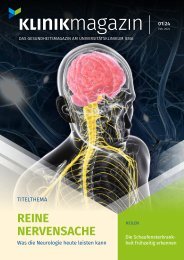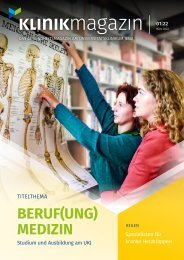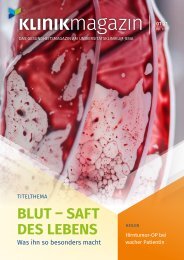Erfolgreiche ePaper selbst erstellen
Machen Sie aus Ihren PDF Publikationen ein blätterbares Flipbook mit unserer einzigartigen Google optimierten e-Paper Software.
Institut für Anatomie II<br />
Institute of Anatomy II<br />
Nach der Emeritierung von Prof. Dr. Karl-Jürgen Halbhuber zum<br />
31.3.<strong>2009</strong> wurde Prof. Dr. Gustav Jirikowski mit der kommissarischen<br />
Leitung des Institutes beauftragt. Zum 1.11.<strong>2010</strong> nahm Prof.<br />
Dr. Andreas Gebert den Ruf auf diesen Lehrstuhl an.<br />
Wissenschaftlicher Schwerpunkt in den Jahren <strong>2009</strong> und <strong>2010</strong><br />
war die Erforschung der Wechselwirkung von Steroidhormonen<br />
und Neuropeptiden im zentralen Nervensystem. Das methodische<br />
Spektrum umfasst licht- und elektronenmikroskopische Histochemie,<br />
in situ Hybridisierung, RT-PCR sowie Immunoassays.<br />
Direktor: Prof. Dr. med. Andreas Gebert<br />
Adresse: Teichgraben 7, 07743 Jena<br />
Andreas.Gebert@med.uni-jena.de<br />
www.anatomie2.uniklinikum-jena.de<br />
After the retirement of Prof Halbhuber, 31.3.<strong>2009</strong>, Prof Jirikowski<br />
was appointed temporary director of the institute. Prof Gebert<br />
accepted chairmanship Nov. 1st <strong>2010</strong>.<br />
Scientific focus in <strong>2009</strong>, <strong>2010</strong> was the interaction of steroid hormones<br />
and neuropeptides in the central nervous system. Methods<br />
include light and electron microscopical histochemistry, in situ<br />
hybridization, RT PCR and immunoassays.<br />
1 2<br />
Forschungsprojekte<br />
Research projects<br />
Lokalisation von Steroid-Bindungsproteinen in Nervenzellen<br />
des Hypothalamus<br />
(Prof. Dr. Gustav Jirikowski)<br />
Der Hypothalamus ist ein Teil des Zwischenhirns, der unter anderem<br />
die Hormone Vasopressin und Oxytocin produziert. Die Bildung<br />
und Ausschüttung dieser Hormone, die den Blutdruck bzw.<br />
die Reproduktion steuern ist von Steroidhormonen der Nebenniere<br />
und der Keimdrüsen abhängig. Bisher wurde angenommen, dass<br />
die Steroidwirkung ausschließlich über spezifische Rezeptoren im<br />
Zellkern funktioniert. Unsere Befunde legen nahe, dass es noch<br />
weitere Mechanismen geben muß, die Steroid-Bindungsglobuline<br />
mit einem eigenen Rezeptorweg involvieren. Diese Bindungsproteine<br />
werden auch in hypothalamischen Nervenzellen produziert.<br />
Fluoreszenz-Markierung von Steroidhormonen<br />
(PD Dr. Reimar Krieg, Prof. Dr. Gustav Jirikowski, Dr. Annett Eitner)<br />
Aufnahme und Bindung von Steroidhormonen in vivo und in vitro<br />
kann bisher nur schlecht untersucht werden. Im Zeitraum 04/<strong>2009</strong><br />
bis 12/<strong>2010</strong> wurden deshalb 46 Steroid-Fluorochrom-Konjugate<br />
mit potentieller Hormonaktivität und mit variierenden physikochemischen<br />
Eigenschaften synthetisiert und patentiert. Sie werden<br />
z.T. sehr effizient bei sehr geringer Zytotoxizität von lebenden Zellen<br />
aufgenommen und sind Ausgangspunkt für Echtzeit-in-vivo-<br />
Untersuchungen zur Aufklärung von Steroid-Protein-Wechselwirkungsmechanismen.<br />
Synthese und Charakterisierung von Steroide-Derivaten<br />
als neuartige oral wirksame Antimalaria-Wirkstoffe<br />
(PD Dr. Reimar Krieg)<br />
Gegenwärtig sind in 108 Ländern ca. 3 Milliarden Menschen von einer<br />
Malaria-Infektion bedroht (1 Mio Tote jährlich allein in Afrika).<br />
Die schnelle Entwicklung von Arzneimittel-Resistenzen durch den<br />
Erreger Plasmodium falciparum macht die Suche nach prinzipiell<br />
neuen Wirkstoffen zu einem zentralen Anliegen. Anknüpfend an<br />
zurückliegende Arbeiten mit Steroiden konnten in Kooperation mit<br />
der JLU Giessen Verbindungen mit starker Antimalaria-Aktivität im<br />
Tiermodell gefunden, modifiziert und patentiert werden. Sie sind<br />
Ausgangspunkt für vielversprechende Struktur-Eigenschaftsuntersuchungen<br />
mit dem Ziel der Entwicklung eines Pharmakons.<br />
Weitere Projekte<br />
Elektronenmikroskopische Untersuchungen zu Veränderungen<br />
der Niere nach Schwermetallvergiftung<br />
(Dr. Hartmut Oehring)<br />
Polarisationsmikroskopische Untersuchungen zur zellulären<br />
Aufnahme von Nanopartikeln (Dr. A. Eitner)<br />
Abb.1: Beispiel für Struktur-Eigenschafts-Betrachtungen an synthetisierten<br />
iso-π-elektronischen Reaktiv-Farbstoffen: Von Peroxidasesubstraten<br />
(linkes Beispiel) zu Kernfarbstoffen (rechts).<br />
Fig.1: Example for structure-property-considerations on iso-πelectronic<br />
reactive stains: left: PO-substrates, right: nucleic stains.<br />
Neuartige Reaktiv-Fluorochrome zum histochemischen<br />
Nachweis peroxidatischer Aktivität<br />
(PD Dr. Reimar Krieg, Dr. Annett Eitner)<br />
Peroxidase (PO) nimmt als Enzymmarker, insbesondere in amplifizierenden<br />
Detektionssystemen, eine Spitzenstellung ein. Im Gegensatz<br />
dazu und angesichts rasanter gerätetechnischer Fortschritte<br />
und wachsender Anforderungen an moderne Detektionssysteme<br />
(z.B. „IHC-multiplexing“) ist die Zahl an leistungsfähigen Substraten<br />
sehr begrenzt und unzureichend (nur rot-braune bis schwarze<br />
Chromogene, Fluoreszenz: nur „Tyramide“). Arbeiten zu inzwischen<br />
patentierten neuartigen PO-Substraten zum Nachweis immungebundener<br />
und endogener PO-Aktivität wurden fortgeführt. Struktur-Eigenschafts-Studien,<br />
Synthese und histologisches Screening<br />
führten auch zur Entwicklung neuartiger Fluoreszenzsonden für<br />
andere Targets, z.B. zu Markern für Mastzellen, Keratin, Knorpel,<br />
Nukleinsäuren und cytotoplamatischer RNA (Abb.1).<br />
Einfluss der Beschichtung von Nanopartikeln auf deren<br />
Internalisierung und Zelltoxizität (Dr. Annett Eitner)<br />
Die Oberflächeneigenschaften von Nanopartikeln haben einen großen<br />
Einfluss auf die Aufnahme und die Verträglichkeit der Partikel<br />
in Zellen. Die Beschichtung der Nanopartikel bestimmt deren<br />
Membranaffinität sowie deren zelluläre Toxizität unabhängig vom<br />
eigentlichen Kernmaterial. Eine hohe Aufnahme von Nanopartikeln<br />
ist erwünscht bei therapeutischen Anwendungen sowie bei<br />
der Wärmebehandlung in der Tumortherapie. Aus diesem Grund<br />
untersuchten wir 20 Eisenoxid-Nanopartikel mit unterschiedlichen<br />
Beschichtungen hinsichtlich ihres Verhaltens zur Internalisierung<br />
und Zytotoxizität mittels konfokaler Laserscanningmikroskopie<br />
und Rasterelektronenmikroskopie. Es zeigten sich hierbei große<br />
Unterschiede in Abhängigkeit der Beschichtung (Abb.2).<br />
Localization of steroid-binding proteins in hypothalamic<br />
neurons<br />
The hypothalamus, part of the diencephalon is source of the posterior<br />
lobe peptides vasopressin and oxytocin. Synthesis and secretion<br />
of these hormones, controlling blood pressure and reproduction<br />
depends on serum levels of adrenal and gonadal steroids.<br />
So far it has been assumed that steroid actions are exclusively mediated<br />
through nuclear receptors and direct genomic effects. Our<br />
findings suggest that additional mechanisms exist which involve<br />
steroid binding globulins and specific membrane receptors. These<br />
binding proteins are expressed in hypothalamic neurons.<br />
Fluorescence labeling of steroid hormones<br />
Uptake and binding of steroid hormones in vivo and in vitro has<br />
been difficult to observe so far. Therefore, a series of 46 chimeric<br />
steroid-fluorochrome conjugates with varying physico-chemical<br />
properties was synthesized. Some of these compounds exhibit high<br />
uptake rates by living cells and negligible cytotoxicity and provide<br />
promising tools for real time in vivo investigation of steroid-protein<br />
interactions.<br />
Synthesis and characterization of steroid-derived compounds<br />
as novel orally active antimalarials<br />
Currently, there are around 3 billion people at risk of malaria infection<br />
in 108 countries and there are up to 1 million deaths only<br />
in Africa. Due to rapid development of resistance by the causative<br />
parasite Plasmodium falciparum to established antimalarials, urgent<br />
efforts are needed to identify effective, affordable, alternative<br />
drugs. In connection with previous work on steroids and in collaboration<br />
with the JLU Giessen, compounds with strong antimalarial<br />
activity could be prepared. They now serve as lead compounds for<br />
SAR and ongoing antimalarial drug discovery<br />
Novel reactive fluorochromes for histochemical detection<br />
of peroxidatic activity<br />
Peroxidase (PO) plays a key role in many sophisticated detection systems.<br />
However, the number of powerful PO substrates lags behind<br />
technical advances and increasing demands on modern detection<br />
systems (e.g. IHC-multiplexing). The small number of chromogenic<br />
substrates currently available yields red-brown to brownish-black<br />
reaction products only, while fluorescence applications are based<br />
excusively on „tyramides“. Thus, novel substrates for histochemical<br />
detection of immunobound and endogenous PO activity were developed<br />
by our group and optimized by chemical tailoring. Also, in<br />
continuation of this work, novel stains for histochemical detection<br />
of mast cells, keratiin, cartilage, nucleic acids, and cytoplasmatic<br />
RNA were obtained by structure-property-investigations, chemical<br />
synthesis, and histochemical screening (Fig.1).<br />
Abb.2: Internalisierung von Stärke-beschichteten magnetischen<br />
Nanopartikeln in BT474-Zellen: 1) CLSM-Aufnahme, Darstellung<br />
der Zellkerne (blau), Nanopartikel (grün) und Zellmembran (rot) 2)<br />
Rasterelektronenmikroskopische Aufnahme: Detektion der Sekundärelektronen<br />
bzw. der Rückstreuelektronen.<br />
Fig.2: Internalization of magnetic nanoparticles in BT474-cells: 1)<br />
CLSM-image, nuclei (blue), nanoparticles (green) and cell membrane<br />
(red) 2) Scanning electron microscopy: Detection of secondary electrons<br />
and back-scattered electrons (BSE).<br />
Influence of nanoparticle coatings on internalization<br />
and cytotoxicity<br />
The chemical and surface properties of nanoparticles have major<br />
impact on the internalization process and biocompatibility. The<br />
coating material, and in particular the surface charge, often determines<br />
membrane affinity as well as cytotoxicity of nanoparticles<br />
independently of their core material. A high internalization of nanoparticles<br />
is desirable for drug or gene delivery as well as for hyperthermia<br />
cancer treatment. We investigated 20 different types of<br />
magnetic nanoparticles with identical core materials but different<br />
coatings. The intracellular uptake of these particles was observed<br />
using confocal laser scanning microscopy and scanning electron<br />
microscopy. The nanoparticles showed a heterogeneous behaviour<br />
depending on their coating materials (Fig.2).<br />
Further projects<br />
Electron microsopical investigations on renal morphology<br />
after heavy metal intoxication<br />
Polarization microscopical observations of cellular uptake<br />
of nanoparticles<br />
Publications<br />
• Jirikowski GF, et al. Distribution of vitamin D binding protein<br />
(DBP) expressing neurons in the rat hypothalamus. Histochem.<br />
Cell Biol., <strong>2009</strong>, 131:365-370<br />
• Pusch L, et al. Expression of corticosteroid binding globulin in human<br />
astrocytoma cell line. Cell. Mol. Neurobiol., <strong>2009</strong>, 29:583-588<br />
• Sivukhina E, et al. Altered hypothalamic-pituitary adrenal axis<br />
activity in patients with chronic heart failure. Horm. Metab. Res.,<br />
<strong>2009</strong>, 41:1-7<br />
• Sivukhina E, et al. Comparison of vasopressin and oxytocin<br />
expressions in the hypothalamo-neurohypophysial system of<br />
patients with chronic heart failure. Horm. Metab. Res. <strong>2010</strong>,<br />
42:56-60<br />
• Krieg R, Halbhuber KJ. Detection of endogenous and immunobound<br />
peroxidase - The status quo in histochemistry. (Review)<br />
Progress in Histochem. Cytochem., <strong>2010</strong>, 45/2:81-142<br />
12|13

















